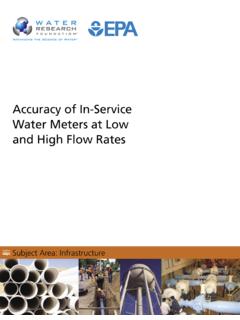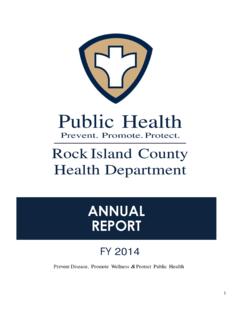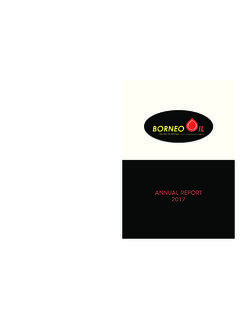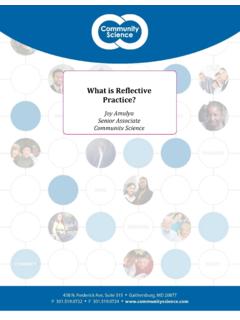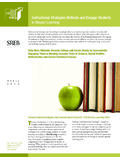Transcription of Process Water - allianceforwaterefficiency.org
1 Process Water Water used by industries and businesses to produce a product or affect a Process is known as Process Water . This section discusses the following industries and Few in- their uses of Process Water : dustrial food and beverages processes auto repair and service involve no paper manufacturing metal finishing need for Water . In The chapter will not cover opportunities to save Water by using efficient plumbing every in- fixtures and irrigation systems, since these are covered elsewhere in this report. dustry that uses wa- While much of the information herein is specific to the product being manufac- ter, careful tured or service being provided, the potential to design Water conservation into the Process ranges from simply adjusting the equipment or Process to use less Water planning to adopting new practices or processes that use no Water at all.
2 And design can mini- Food-and-Beverage Processing mize Water waste and The food-and-beverage-processing industry includes a wide range of products and optimize manufacturing processes: the ben- bakery/pastry shops industrial bakeries efits re- breweries ceived from wineries the Water soft drink and juice manufacturers that is dairy-food processors consumed. meat, fish, and poultry processing frozen-food producers canneries snack-food manufacturers grocery stores and restaurants that produce food products for sale other food and drink processors The food-and-beverage industry uses Water for many purposes. The quality and purity of the Water is of primary concern since it is used to make products that will be consumed. Water is also used to clean and sanitize floors, processing equipment, containers, vessels, and the raw food products prior to their Process - ing.
3 Hot Water , steam, cooling, and refrigeration also require source Water . De- signing and building a facility that has a reduced requirement for Water includes: designing the facility for ease of cleaning providing adequate metering, submetering, and Process control taking advantage of dry methods for cleanup and transport PROC1. Process Water Watersmart Guidebook using product- and byproduct-recovery systems incorporating Water reuse and recycling designing for minimal or no Water use Description of End-Use and Water -Savings Examples Because of the complicated and highly varied nature of the food and beverage manufacturing industry, providing a simple guide to Water efficiency that covers all types of facilities is not possible. Before beginning this discussion of Water conservation in food processing, one should remember that health and sanitation are overriding concerns.
4 All actions to reduce Water use must be measured against this pri- mary consideration. The following example illustrates ways Water can be used in the soft-drink industry. Potable Water is first treated to soften it and, if needed, to remove additional minerals. It is chilled and blended with flavorings and sweeteners, then carbonated. Cans or bottles are filled and sealed, then rinsed and sent through a warming bath to avoid creating condensate in the open air and ensure they are dry before packing. The eight major Water -using processes are: Water softening, which requires periodic filter backwash Water included in the product Water to clean and rinse cans Water to warm cans after processing Water sprayed on the conveyor line as a lubricant Water to operate cooling towers for refrigeration equipment and boilers for heat Water to sanitize and clean the plant and vessels Water for employee sanitation, irrigation, etc.
5 (North Carolina Department of Environment, Health, and Natural Resources, 1998). Carbonated Soft Drink Manufacturing Cooling /. Proportioner Carbonation Water Treatment Finished Syrup Carbon Product Dioxide Other Conveyor Water Operation . Use Labeling, Inspection & Packing Bottling Based upon PROC2. Watersmart Guidebook Process Water Each of eight major Water -using activities in the food- and beverage-manufacturing sector will be de- scribed, along with examples from specific industries where appropriate: cleaning and sanitation thermodynamic processes transportation and cleaning of food products equipment cleaning container (bottles, cans, cartons, etc.) cleaning lubricating can and bottle conveyor belts can and bottle warming and cooling product ingredients Cleaning and Sanitation Information on floor cleaning and the cleaning of outdoor areas is found in all sectors (see Food Ser- vice ).
6 Dry cleanup, preventing spills by controlling processing equipment and leaks, and proper storage and handling of ingredients all reduce Water needed for cleaning. The following table summarizes the importance of Water for cleaning in four food-processing sectors (Environmental Technology Best Practices Program). Water Use by Major Food-Processing Types Percent of Water for Type of Process Cleaning Bakery 70. Soft drink 48. Brewing 45. Jam 22. Thermodynamic Processes Another common use of Water is in the production of steam and hot Water and in cooling towers, as discussed in the section on Thermodynamic Processes. Metering and submetering are important in un- derstanding how much Water is used in each Process or type of equipment. Proper Process controls are essential to managing Water and energy use.
7 Transportation and Cleaning of Food Products The use of flumes to both transport and clean produce (fruits and vegetables) is common. Water is also used in the cleaning and processing of meat, poultry, and fish. Common Water -conservation techniques begin with reducing Water use by: recycling transport Water adjusting design of flumes to minimize Water use using flumes with parabolic cross sections providing surge tanks to avoid Water loss using float control valves on makeup lines use solenoid valves to shut off Water when equipment stops PROC3. Process Water Watersmart Guidebook All these techniques can reduce the need for Water , but changing the Process has even more potential. Replace fluming with conveyor belts, pneumatic systems, or other dry techniques to move food products.
8 Install sprays to wash food. Use mechanical disks and brushes. Install counter-flow washing systems. Control sprays on belts. Control Process equipment to reduce waste. Grocery stores and smaller bakeries should follow good food-service sector washing practices for meats, fruits, vegetables, and other food products before final packaging. Further, ensure that all Water -using Process equipment has proper level and flow controls (Costello). As an example, a Minnesota vegetable-processing firm reduced Water use for conveying corn by 20 per- cent, or 1,000 gpd, just by employing proper controls and recycling 20 percent of the Water in the flumes (North Carolina Department of Environment and Natural Resources). Equipment Cleaning Equipment to be cleaned ranges from large Process facilities and equipment to the hand-held equipment and cooking utensils found in smaller bakeries and grocery stores.
9 Smaller utensils should be washed following the ware-washing considerations found in the Food Service section. Larger equipment that cannot be disassembled easily must be cleaned in place. Choices of procedures for cleaning equipment can yield multiple advantages including: product recovery reduced wastewater loading reduced Water use reduced chemical use Good design and layout of equipment are essential to easy cleaning. Design equipment that minimizes spills, leaks, and residual product that must be removed before cleaning. For closed systems such as tanks and piping, eliminate low spots so equipment can easily and completely drain. Provide easy access to all areas of the equipment that must be cleaned. Select materials and surfaces that are easily cleaned.
10 Change procedures to reduce the need for cleaning. As an example, a medium-sized bakery in Minnesota used 65 to 100 buckets a day for storing icing. Washing these buckets required approximately three hours of labor each day, and icing that stuck to the bottom and sides was wasted. They replaced the one-bucket-at-a-time preparation method with a large vat. This reduced the number of containers that had to be washed to three large ones and saved up to $2,000 a year in icing that was being wasted. It also reduced washing time from three hours a day to a few minutes, thus saving Water (Minnesota Technical Assistance Program). Clean-in-place methods range from flooding the equipment with hot Water , detergent, and chemicals, to dry cleaning. Dry cleaning as a first step is essential for saving Water , since it reduces the Water needed in the wet-cleaning phase, sometimes eliminating it completely.

